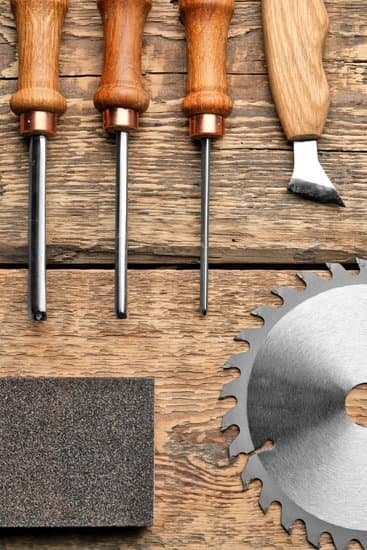Woodworking is an ancient craft that has continually evolved with the introduction of new tools and techniques. One such tool that has greatly impacted the precision and efficiency of woodworking is the shaper. In this article, we will explore the history and development of the shaper in woodworking, tracing back its origins to its modern-day use.
A shaper in woodworking refers to a specialized machine used for shaping and cutting wood. It is designed to create various profiles and mouldings on wooden surfaces by using a spinning cutter, known as a cutterhead, along with specific templates or guides. Unlike other woodworking machines like routers or planers, shapers are primarily used for larger and more complex projects that require intricate detailing.
The importance of the shaper in woodworking cannot be overstated. Its ability to shape wood with precision allows craftsmen and artisans to create ornate designs and decorative elements for furniture, cabinetry, trim work, and other wooden structures. Additionally, its versatility allows it to perform various tasks like rabbeting, grooving, coping, and tenoning, making it an indispensable tool for professional woodworkers across different industries.
In the next sections of this article, we will delve deeper into the history of woodworking tools and examine how the need for improved efficiency led to the innovation of the shaper. We will also trace back its origins and discuss early forms of the shaper compared to modern versions. Join us on this journey through time as we uncover the fascinating story behind when the shaper was invented in woodworking.
The Evolution of Woodworking Tools
The history of woodworking tools dates back to ancient times, with early civilizations using primitive tools made from stone, bone, or wood. As technology advanced, so did the tools used in woodworking. This section will provide a brief overview of the evolution of woodworking tools and highlight the need for improved efficiency and precision.
Primitive Tools
In the earliest days of woodworking, craftsmen used simple hand tools such as axes, adzes, and chisels to shape and carve wood. These primitive tools required immense physical strength and skill to produce desired results. Though these tools were effective for their time, they lacked the precision and speed required for complex woodworking tasks.
Advancement in Technology
With the advent of metalworking techniques, better-quality woodworking tools began to emerge. The use of iron and steel allowed for sharper edges on saws and other cutting implements. Advancements in metallurgy also led to the development of more durable tool handles, increasing their longevity and reliability.
The Birth of Power Tools
In the 19th century, power-driven machinery became increasingly popular in various industries, including woodworking. The invention of steam-powered engines enabled the creation of large-scale machinery capable of performing repetitive tasks with greater ease. This led to the birth of power equipment such as lathes, planers, and shaping machines.
It became evident that there was a need for improved efficiency and precision in woodworking as demand for finely crafted furniture grew. Woodworkers sought tools that could replicate intricate designs accurately without compromising quality. This desire for advancements drove inventors to develop new technologies specifically tailored to meet these needs.
Origins and Early Forms of the Shaper
The origins of the shaper in woodworking can be traced back to ancient civilizations. In ancient Egypt and Greece, craftsmen utilized various hand tools to shape and carve wood, such as chisels, saws, and rasps. However, these early tools required a significant amount of physical effort and lacked precision in achieving intricate designs.
The earliest forms of the shaper were rudimentary machines that utilized manual power to shape wood. One such early version was the treadle-powered shaper, which emerged during the 16th century in Europe. This machine incorporated a foot-operated mechanism that allowed craftsmen to rotate a cutting tool against a workpiece.
During the 18th century, advancements were made in the form of overhead shapers. These machines featured a rotating spindle mounted on an overhead support structure, allowing for more precise shaping and cutting. Overhead shapers became increasingly popular among woodworkers as they provided more control over the shaping process.
Despite these early developments, these early versions of shapers were limited in their efficiency compared to modern ones. They often lacked stability and had limited capabilities when it came to shaping complex profiles or executing intricate designs. Additionally, these early machines were usually operated by skilled craftsmen and required significant manual labor.
It wasn’t until the Industrial Revolution in the late 18th century that significant improvements were made in shaper technology. The invention of steam power introduced a new era for woodworking machinery, including shapers. Steam-powered shapers became more widely used due to their increased power capacity and automation capabilities. This revolutionized woodworking practices by increasing efficiency, precision, and productivity.
Today’s modern shapers have evolved significantly from their humble origins. They are now sophisticated machines that combine computer numerically controlled (CNC) technology with advanced cutting tools and materials. These machines can shape wood with incredible precision and speed, saving woodworkers significant time and effort.
Revolutionary Innovations in the Shaper
The invention and development of the shaper in woodworking has seen numerous revolutionary innovations that have greatly impacted the industry. Over time, advancements in technology and design have led to the creation of more efficient and precise shapers, revolutionizing woodworking practices.
One major groundbreaking innovation in the development of the shaper was the introduction of power-driven shapers. In the early days, shapers were operated manually, requiring physical force from woodworkers to shape and cut wood. However, with the advent of power-driven shapers, woodworkers were able to achieve greater efficiency and precision in their work. Power-driven shapers also allowed for faster production rates, making it possible to complete projects in a shorter amount of time.
Another significant innovation was the incorporation of adjustable features in shaper design. Early forms of shapers had limited capabilities when it came to adjusting settings such as feed rate or depth of cut. However, with advancements in design, modern shapers now come equipped with adjustable features that allow woodworkers to customize their shaping and cutting processes based on their specific needs. This level of adjustability has greatly improved versatility and flexibility in woodworking operations.
Additionally, improvements in safety features have been a key revolutionary innovation in modern shapers. Early versions lacked proper safety mechanisms, posing significant risks for woodworkers during operation. However, with increased focus on worker safety, modern shapers are equipped with safety guards and emergency stop mechanisms, reducing the likelihood of accidents and injuries.
These revolutionary innovations have transformed the woodworking industry by elevating efficiency, precision, versatility, and safety standards. Woodworkers today can rely on advanced shaper technology to accomplish intricate designs with ease while minimizing risks. As technology continues to advance rapidly, it is likely that future innovations will further enhance the capabilities and performance of shapers in woodworking operations.
| Innovation | Description |
|---|---|
| Power-driven shapers | Introduction of power-driven shapers revolutionized woodworking practices by increasing efficiency, precision, and production rates. |
| Adjustable features | Incorporation of adjustable features in modern shapers provided woodworkers with greater versatility and flexibility in shaping and cutting processes. |
| Safety mechanisms | Improved safety features in modern shapers, such as safety guards and emergency stop mechanisms, have significantly reduced the risks and accidents associated with woodworking operations. |
Key Pioneers in the Invention of the Shaper
The invention and development of the shaper in woodworking would not have been possible without the contributions of several key pioneers. These individuals played a significant role in shaping the history of woodworking through their innovative ideas and inventions. Let’s take a closer look at some of these important figures.
One notable pioneer in the invention of the shaper is Samuel Bentham, an English mechanical engineer and naval architect. In 1791, Bentham patented a machine called a “profile lathe,” which was one of the earliest forms of a shaper. This machine allowed for more precise shaping and cutting of wood, paving the way for future advancements in shaping technology.
Another important figure in the development of the shaper is Thomas Blanchard, an American inventor. In 1827, Blanchard patented his invention known as the “copying lathe.” This machine revolutionized woodworking by allowing craftsmen to replicate intricate shapes with great precision. Blanchard’s invention laid the foundation for modern-day shapers and greatly influenced subsequent designs.
In addition to Bentham and Blanchard, other inventors made significant contributions to the invention and improvement of the shaper. Robert Hooke, an English scientist, designed a machine that used templates to guide cutting tools for shaping wood in 1678. William Woodworth introduced a self-acting feed mechanism for shapers in 1848, further enhancing their efficiency.
These pioneers paved the way for future advancements in shaping technology and their contributions continue to resonate within the woodworking industry today. Their inventions laid a solid foundation upon which modern shapers have been built, making woodworking processes faster, more efficient, and more precise than ever before.
As we continue exploring the evolution and development of shapers in woodworking, it is crucial to acknowledge these key pioneers who dedicated their time and expertise to push boundaries and expand possibilities within this field. Without their groundbreaking innovations, the shaper as we know it today would not exist, and woodworking practices would not have reached the level of precision and efficiency that they have achieved.
Important Milestones and Years in Shaper Development
The development of the shaper in woodworking has seen several important milestones and breakthroughs throughout history. These key moments have played a crucial role in shaping the evolution of this tool and revolutionizing woodworking practices. This section will provide an overview of some of the significant milestones and years in shaper development.
One of the earliest recorded milestones in shaper development can be traced back to the early 1800s when James Fox invented a machine called the reciprocating brace or chucking machine. This machine utilized rotary cutters to shape and smooth wood, marking a significant advancement in shaping technology.
Another important milestone occurred in 1823 when J.W. Putnam patented a shaper-like device that incorporated various shaping techniques such as turning, grooving, fluting, and cylinder cutting. This patent showcased early attempts to combine multiple shaping functions into one machine, foreshadowing the versatility that modern shapers possess.
A major breakthrough came in 1850 with the invention of the adjustable sliding table shaper by R.E. Debrelle. This innovation allowed woodworkers to adjust workpiece placement and movement during shaping operations, increasing efficiency and precision. The adjustable sliding table became a fundamental feature still present in modern shapers today.
In more recent history, advancements in computer numerical control (CNC) technology have greatly impacted shaper development. In 1984, Bridgeport Machines introduced the first CNC shaper, which allowed for automated control over cutting paths and increased accuracy. This marked a major advancement in precision shaping capabilities and paved the way for further technological advancements.
These milestones represent just a fraction of the many years and innovations that have contributed to shaping the development of shapers in woodworking. Each step forward has pushed the boundaries of what is possible with this tool, leading to greater efficiency, precision, and versatility for woodworkers worldwide.
Important Milestones and Years in Shaper Development
- Early 1800s: Invention of the reciprocating brace or chucking machine by James Fox
- 1823: Patent for a versatile shaping device by J.W. Putnam
- 1850: Introduction of the adjustable sliding table shaper by R.E. Debrelle
- 1984: Introduction of the first CNC shaper by Bridgeport Machines
Overall, these milestones have shaped the legacy of the shaper in woodworking, continually pushing the boundaries of what is possible with this tool. As technology continues to advance, it is exciting to speculate on future possibilities and advancements in shaper design and functionality. The rich history and ongoing development of the shaper highlight its enduring significance in the woodworking industry.
Popularity and Adoption of Shapers in the Woodworking Industry
The popularity and adoption of shapers in the woodworking industry have grown significantly over the years. With their ability to shape and cut wood with precision and efficiency, shapers have become indispensable tools for woodworkers. The increased use of shapers has revolutionized woodworking processes, allowing for greater versatility and improved craftsmanship.
One of the key reasons for the growing popularity of shapers is their ability to enhance efficiency in woodworking. Shapers are designed to provide consistent cuts and shapes, reducing the need for manual precision and minimizing errors.
This saves time and effort for woodworkers, allowing them to complete projects more quickly and efficiently. Additionally, shapers offer a range of cutting options, such as molding, grooving, and dadoing, making them versatile tools that can be used for a variety of woodworking tasks.
Another factor contributing to the adoption of shapers is their ability to provide precise shaping capabilities. Shapers allow woodworkers to create intricate designs and patterns on wood surfaces with ease. The adjustable fences and various cutting profiles available with modern shapers enable woodworkers to achieve highly detailed shapes and contours. This level of precision was not easily achievable with traditional hand tools or earlier forms of shaping machines.
In addition to efficiency and precision, using shapers offers several other benefits compared to traditional tools in woodworking. Shapers can handle larger pieces of wood compared to handheld power tools like routers, making them suitable for larger-scale projects. They also provide better control over cuts due to their stationary nature, reducing the risk of accidents or injuries. Furthermore, with advancements in technology and design, modern shapers come equipped with safety features such as emergency stops and automatic braking systems.
As a result of these advantages, shapers have gained immense popularity among both professional woodworkers and hobbyists. Their widespread adoption has led to advancements in shaper technology and an expansion in the availability and variety of shaper models in the market.
| Year | Milestone/Development |
|---|---|
| 1920 | Introduction of the first motorized shaper for shaping wood |
| 1960 | Invention of the power feeder, which improved feeding and stability during shaper operations |
| 1985 | Advancements in cutter head technology with the introduction of carbide-tipped cutters that provided longer life and better cutting performance |
| 2000 | The development of computer numerical control (CNC) shapers with advanced automation capabilities for precise and complex shaping tasks |
Despite these advancements, there is still room for future possibilities and advancements in shaper technology. One potential area of improvement is the integration of smart features, such as automated tool change systems and real-time monitoring sensors, to enhance productivity and user-friendliness. Another possibility is the incorporation of machine learning algorithms to optimize cutting parameters based on specific wood types and shapes. These advancements could further streamline woodworking processes and unlock new creative possibilities for woodworkers.
Modern Shapers and Future Possibilities
As technology continues to advance, woodworking tools have also undergone significant developments. The modern shaper represents the culmination of these advancements, providing woodworkers with a range of features and capabilities that were unimaginable in the early days of woodworking. In this section, we will explore the state of modern shapers and discuss the possibilities for future advancements in shaper technology.
Features of Modern Shapers
Modern shapers come equipped with a variety of features that enhance their efficiency and precision in shaping and cutting wood. One notable feature is the inclusion of digital controls that allow woodworkers to program specific cutting patterns, ensuring consistent results. This automation saves time and reduces the margin for error, making it easier for both professionals and hobbyists to achieve their desired outcomes.
Another important feature of modern shapers is their compatibility with computer-aided design (CAD) software. This integration allows woodworkers to create intricate designs digitally, which can then be translated into precise cuts by the shaper. CAD compatibility opens up endless possibilities for creativity and experimentation in woodworking projects.
Possibilities for Future Advancements
While modern shapers have already revolutionized woodworking practices, there are still possibilities for further advancements in the future. One area that holds promise is the integration of artificial intelligence (AI) into shapers. AI could enable the shaper to analyze wood grain patterns and make real-time adjustments to optimize cutting, resulting in even greater precision.
Additionally, there is potential for further miniaturization and portability of shapers without compromising their performance or capabilities. Compact yet powerful shapers would enable woodworkers to bring their craft on-the-go or work on projects with limited space.
Furthermore, advancements in materials science may lead to the development of more durable and efficient cutting blades for shapers. Innovations such as diamond-coated blades could prolong blade life while maintaining sharpness, reducing the need for frequent blade replacements and ultimately saving time and resources.
Overall, modern shapers have already transformed woodworking practices, but the field of possibilities for future advancements remains wide open. With the continued integration of technology and the exploration of new materials and techniques, we can expect even more remarkable developments in shaper technology in the years to come. Woodworkers will undoubtedly benefit from these advancements as they continue to push the boundaries of their craft.
Conclusion
In conclusion, the shaper has played a significant role in shaping and cutting wood throughout the history of woodworking. From its origins as early forms and prototypes to the revolutionary innovations that have led to modern shapers, this powerful tool has transformed woodworking practices and revolutionized the industry.
The development of the shaper has been driven by a constant need for improved efficiency and precision in woodworking. As technology advanced, so did the capabilities of the shaper, allowing for greater control and accuracy in shaping wood. The groundbreaking innovations in design and technology have made it possible for woodworkers to achieve intricate and complex designs with ease.
Throughout history, there have been key pioneers who have made significant contributions to the invention and development of the shaper. These individuals have pushed the boundaries of what is possible in woodworking, constantly seeking ways to improve upon existing tools and techniques. Their inventions and advancements have paved the way for future generations of woodworkers to continue pushing the limits of their craft.
The popularity and adoption of shapers in the woodworking industry continue to grow, as more professionals recognize the benefits they offer compared to traditional tools. Shapers have greatly enhanced efficiency and precision in woodworking processes, allowing craftsmen to produce high-quality work in less time. As technology continues to advance, it is exciting to speculate on future possibilities and advancements in shaper technology.
Frequently Asked Questions
What is a shaper in woodworking?
In woodworking, a shaper is a machine used to shape or mold wood. It consists of a spindle that holds cutting tools such as blades, bits, or cutters.
The spindle rotates at high speeds, allowing the tools to carve or shape the wood based on the desired design or pattern. Shapers are commonly used to create decorative edges, profiles, and mouldings on wooden pieces, making them an essential tool in many woodworking shops.
Why use a shaper instead of a mill?
There are several advantages to using a shaper instead of a mill in certain woodworking applications. First and foremost, shapers offer greater versatility when it comes to shaping wood profiles and mouldings due to their ability to accommodate various cutters and blades. They provide more flexibility in terms of adjusting depth, width, and overall shape than mills do.
Additionally, shapers are generally smaller and more compact compared to mills, which makes them suitable for smaller workshops or projects with limited space. Lastly, using a shaper can often be more cost-effective than employing a mill for specific shaping tasks since mills tend to be larger and designed for heavier-duty work.
When was the spindle moulder invented?
The spindle moulder, also known as a shaper in the United States, was invented in the early 19th century. While there isn’t an exact date associated with its invention, the emergence of the spindle moulder can be attributed to advancements in industrialization during that era. As technology progressed and machinery became more sophisticated, carpenters and woodworkers sought ways to efficiently shape wood for various applications.
This led to the development of the spindle moulder as a specialized machine specifically designed for shaping wood using rotating cutting tools attached to a powered spindle. Since its invention, the spindle moulder has undergone numerous improvements and refinements but remains an integral part of woodworking machinery today.

Hi everyone! I’m a woodworker and blogger, and this is my woodworking blog. In my blog, I share tips and tricks for woodworkers of all skill levels, as well as project ideas that you can try yourself.





